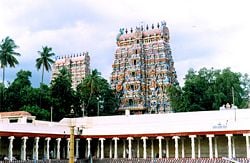Difference between revisions of "Temple" - New World Encyclopedia
m |
m |
||
| Line 10: | Line 10: | ||
[[Image:Madurai-tank.jpg|thumb|250px|right|A Hindu temple is called a mandir in Hindi, koyil in Tamil and gudi in Telugu. Shown here is the famous [[Meenakshi Temple]] in [[Madurai]], [[India]].]][[Image:Temple of Heaven - Courtyard.jpg|thumb|right|250px|[[The Temple of Heaven]], a famous [[Taoism|Taoist]] temple in [[Beijing]]]] | [[Image:Madurai-tank.jpg|thumb|250px|right|A Hindu temple is called a mandir in Hindi, koyil in Tamil and gudi in Telugu. Shown here is the famous [[Meenakshi Temple]] in [[Madurai]], [[India]].]][[Image:Temple of Heaven - Courtyard.jpg|thumb|right|250px|[[The Temple of Heaven]], a famous [[Taoism|Taoist]] temple in [[Beijing]]]] | ||
| − | A '''temple''' is a structure reserved for religious or spiritual activities, such as prayer and sacrifice, or analogous rites (as in masonry). It is a general term for house of [[worship]]. Some religions use this term: | + | A '''temple''' is a structure reserved for religious or spiritual activities, such as prayer and sacrifice, or analogous rites (as in masonry). It is a general term for house of [[worship]]. Some religions use this term, including: |
*[[Hinduism]] | *[[Hinduism]] | ||
*[[Buddhism]] ([[Shaolin]]) | *[[Buddhism]] ([[Shaolin]]) | ||
Revision as of 15:42, 7 January 2006
- For other uses, see Temple (disambiguation).
The word temple has different meanings in the fields of architecture, religion, geography, anatomy, and education.
The word is derived from the both more and less specific Latin word templum ("sacred place") - see Roman temple.
Religion


A temple is a structure reserved for religious or spiritual activities, such as prayer and sacrifice, or analogous rites (as in masonry). It is a general term for house of worship. Some religions use this term, including:
- Hinduism
- Buddhism (Shaolin)
- Temple at Uppsala
- Greek temple
- Temple in Jerusalem
- Mormon temple
- Roman temple
- Reform Judaism's synagogues.
Some religions refer to their temples by a unique word of their own:
- In ancient Rome, only the native deities of Roman mythology had a templum; any equivalent structure for a foreign deity was called fanum.
- A Christian temple is called a church.
- In Western Christianity, some "private" temples are called chapels, while major public ones are designated cathedral (i.e. seat of a diocesan bishop), basilica, or minster.
- In Orthodox Christianity (both Eastern and Oriental) a temple is church with base shaped like Greek cross. See Orthodox temple.
- Protestant denominations installed in France in the early modern era use the word "temple" (as opposed to "church," supposed to be Roman Catholic); some more recently installed Christian denominations use "church."
- A Jain temple is called a derasar.
- A Hindu temple is variously called a mandir (Hindi), a koyil (Tamil), and an gudi/devalayam/kovela (Telugu).
- An Islamic temple is called a mosque (masjid in Arabic)
- In Judaism, the Temple in Jerusalem (Hebrew: בית המקדש, Beit ha Mikdash, literally "House of the Temple") on Temple Mount in Jerusalem was the center of ancient Judaism and the most important holy site in the religion. The First Temple was built in the 10th century B.C.E. under King Solomon to replace the Tabernacle and was destroyed by the Babylonians under Nebuchadnezzar in 586 B.C.E., marking the beginning of the Babylonian exile. The Second Temple was constructed after the return from the Babylonian exile, from around 536 B.C.E. to 515 B.C.E. Herod's Temple was a massive expansion of the Second Temple begun under Herod the Great around 19 B.C.E. It was almost entirely destroyed by Roman troops under Titus in 70 C.E. during the siege of Jerusalem of the First Jewish-Roman War, leaving only the Western Wall. Some synagogues, especially Reform synagogues, are called temples (as in Temple Emanu-El; Temple Beth-El), but Orthodox Judaism considers this inappropriate as they do not consider synagogues a replacement for the Temple in Jerusalem.
- A Sikh temple is called a gurdwara.
- A Zoroastrian temple is called a fire temple.
- In Cambodia and Thailand, both Hindu and Buddhist temples are known as wats.
- Baha'i Temples are known as a "Mashriqul Adhkar"
- Masonic temples are meeting-places for Freemasons, who, though not a religious movement as such, follow some cultic practices in its external forms
- A Shintoist temple is called jinja
Architecture
In various historical periods, specific architectural styles were maintained strictly for major religious structures. These temple structures, along with military and palace structures, have often been the main surviving studied examples of certain kinds of architecture. In particular, Greek and Roman temple architecture has been a major influence in Western public architecture. See list of ancient temple structures.
List of religious temples
For Buddhist temples, see List of Buddhist temples
In Japan:
- Hōryū-ji
- Sensō-ji
- Ryōan-ji
In Taiwan for non-buddist worship:
- Bao-an Temple (大龍峒保安宮)
- Long-shan Temple (龍山寺, Long Shan Si)
External links
- etymology on line - distinct for the religious and anatomical terms
- Mount Temple Climbing Information
- The Hindu Temple - Where Man Becomes God by Sri Nitin Kumar.
ar:معبد
da:Tempel
de:Tempel
et:Tempel
es:Templo
fr:Temple
he:מקדש
id:Candi
la:Templum
hu:Templom
nah:Teokalli
nl:Tempel
ja:寺院
nn:Tempel
pl:Świątynia
pt:Templo
ru:Храм
simple:Temple
su:candi
sv:Tempel
zh:庙宇
Credits
New World Encyclopedia writers and editors rewrote and completed the Wikipedia article in accordance with New World Encyclopedia standards. This article abides by terms of the Creative Commons CC-by-sa 3.0 License (CC-by-sa), which may be used and disseminated with proper attribution. Credit is due under the terms of this license that can reference both the New World Encyclopedia contributors and the selfless volunteer contributors of the Wikimedia Foundation. To cite this article click here for a list of acceptable citing formats.The history of earlier contributions by wikipedians is accessible to researchers here:
The history of this article since it was imported to New World Encyclopedia:
Note: Some restrictions may apply to use of individual images which are separately licensed.


